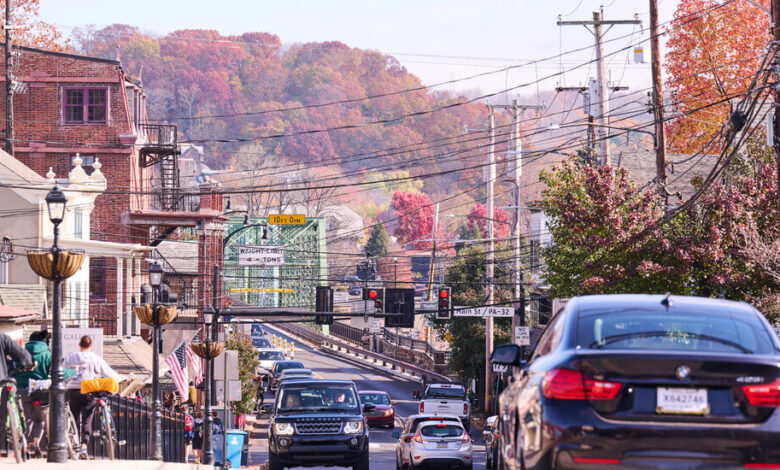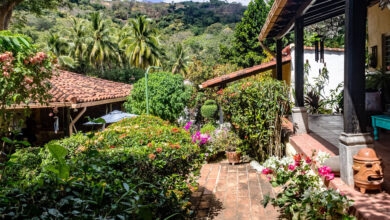New Hope, Pa.: A Walkable River Town With Plenty of Attractions

[ad_1]
When Kim and Mark Breiland lived in Chesterfield, N.J., near the Pennsylvania border, they loved crossing the Delaware River into New Hope, Pa. With fewer than 3,000 residents, the 1.4-square-mile Bucks County borough is small, but has plenty of attractions: historic architecture, galleries, restaurants, shops, a promenade along the river, a steam railroad, and a playhouse in an old mill.
“If it’s a beautiful fall day, yes, it’s busy,” Ms. Breiland said of the borough’s popular Main Street. “But that’s what I love about it.”
So it’s not surprising that Ms. Breiland, a business coach and self-described Jersey girl, and Mr. Breiland, a TV executive who works in New York, eventually bought a house nearby. The couple, both 43, paid $745,000 in July 2021 for a four-bedroom, three-and-a-half-bath house on half an acre west of downtown. Now their favorite weekend activity is parking at the north end of town, walking two miles along the river (and a canal) with their three children, and finding a bench where they can enjoy pastries from a French bakery.
The New Hope-Solebury School District is highly rated, Ms. Breiland said, explaining their reasons for moving, and has “an extremely supportive and proactive approach to special education.” And because they live in Pennsylvania and not New Jersey, the couple pay substantially lower property taxes: about $7,000 a year, compared with $18,000.
They are also within easy reach of big cities — Philadelphia is about 40 miles southwest, and Manhattan is about 70 miles northeast — but “you don’t have to drive to Philly or New York to access big events,” Ms. Breiland said.
New Hope housing tends to be pricey — even outside town, where homes on spacious lots sell quickly. But the pace of life is slower.
Ruth Grannis, 55, a registered nurse who paid $620,000 for a three-bedroom, three-bath 1996 colonial four miles west of town in January 2021, said she often finds herself driving along rural routes not recommended by GPS. She and her 13-year-old daughter and 80-year-old mother moved to the area from Staten Island, N.Y., after her husband, Michael Grannis, a retired police officer, died in 2020.
Mrs. Grannis wanted more space and safety — and less noise and congestion. One night, she said, she awoke at 3 a.m. from a vivid dream in which she got a message: Move to New Hope. “I got up and Googled ‘New Hope’ and said, ‘Oh, this is a nice place.’”
She had forgotten that she and her husband had visited New Hope several years earlier. When she returned for another visit, she fell in love with the area, she said, and found a home that hit the jackpot with her daughter, who is in the eighth grade.
“She loves it,” Mrs. Grannis said. “When we bought it, she just cried. Then she said, ‘I think we made Daddy proud.’”
What You’ll Find
New Hope sits on the west bank of the Delaware River, across a walkable bridge from Lambertville, N.J., its charming neighbor to the east. U.S. Route 202 runs north of town over a toll bridge into New Jersey. State Route 32, known as River Road and Main Street, forms New Hope’s backbone. The borough seems to melt into farmland and rolling hills.
With craft stores, restaurants, art galleries, antiques shops, historic buildings, museums and a playhouse, New Hope is a popular destination in Bucks County — so Main Street is often crowded on weekends. The borough is also attractive to buyers who are downsizing and in search of an interim residence before retiring.
Lisa Baranchuk, an agent with River Valley Realty, said the borough’s vibrancy and walkability are appealing to empty-nesters moving from a city or the suburbs. So are the lower property taxes compared with neighboring New Jersey, although Bucks County is one of the higher-taxed counties in Pennsylvania. (The average property tax rate for the 18938 ZIP code is $3,875, according to the SmartAsset website.)
With the advent of remote work during the pandemic, Ms. Baranchuk said, New Hope is “a major bargain for weary New Jersey residents looking to get away from soaring property taxes.”
What You’ll Pay
In late October, 55 properties were listed for sale in the 18938 ZIP code area, according to information that Ms. Baranchuk provided. They included eight properties in the borough of New Hope, plus others in several smaller communities in the adjacent Solebury Township. The median price between Oct. 1, 2021, and Oct. 1, 2022, was $759,450, or $283 a square foot.
Prices in the borough ranged from $1.1 million (reduced from $1.225 million) for a three-bedroom house with two full and two half bathrooms, high above the Delaware River and within walking distance of downtown, to $3.495 million for a five-bedroom, four-bath penthouse condominium with river views and direct access to the towpath along the river. Prices in the 18938 ZIP code ranged from $160,000 to $6 million.
Sales are down slightly in the area this year, but prices are up. Through September, 201 properties sold for an average of $950,952, with an average time on the market of 52 days. By contrast, the first nine months of 2021 saw 253 properties sell for an average of $868,957 — about 9 percent lower — with an average of 49 days on the market.
The Vibe
Laurence D. Keller, who owns an antiques shop in town and is the borough’s mayor, said New Hope has changed considerably in the past 15 years. The stately Logan Inn has been renovated, the Bucks County Playhouse and Odette’s restaurant have reopened, a riverside promenade was added, and the Four Seasons Mall was turned into Ferry Market.
“It just raised the bar in New Hope,” he said.
The borough’s population, however, has increased by only 150 during that time because there are few places to build new homes. As a result, home prices have risen significantly.
Andrew Aprill, 58, and his wife, Maria Aprill, 51, are among those new residents. The couple, who have three children, ages 14, 18 and 21, recently moved to New Hope from Stockton, N.J., just across the river, paying $1.1 million for a two-bedroom, four-level condominium a block from Main Street. They saw the listing on a Tuesday and were in contract the following day.
“We thought, ‘Wouldn’t it be cool to live like we vacation?’” said Mr. Aprill, who owns a consulting firm downriver, in Bristol, Pa.
New Hope has “always been a destination, a hangout,” he said, “but now it’s more for full-time residents. It was kind of trapped in time — a time warp — but the restaurant scene has broken out.”
And yet there are still tattoo parlors in town, along with the quirky vintage store Love Saves the Day and the formidable Farley’s Bookshop, open since 1967. And motorcyclists often rumble up and down Main Street. “I think it’s awesome that it’s all still there,” Mr. Aprill said.
The Schools
The New Hope-Solebury School District, which serves students in New Hope and Solebury Township, includes two elementary schools — one for kindergarten through second grade, the other for third through fifth grade — a middle school and a high school.
New Hope-Solebury High School was ranked 10th among Pennsylvania’s public high schools by U.S. News & World Report in 2022. The middle school was named a National Blue Ribbon School in September, one of only 10 middle schools in Pennsylvania so honored.
About 81 percent of the district’s 1,300 students identify as white, 7 percent as Hispanic or Latino, 5.5 percent as Asian, 0.4 percent as Black and 6 percent as two or more races. About 10 percent are considered economically disadvantaged.
According to the state’s Department of Education, students taking the SATs in 2019 at New Hope-Solebury High School averaged 608 in math and 596 in reading and writing, compared with state averages of 537 and 545.
The Commute
On a good day, New Hope is a 100-minute drive to New York City on U.S. 202 and Interstate 78. But Mr. Breiland is one of many residents who drive about 20 miles to the New Jersey Transit station in Hamilton Township, N.J., and take the train into Manhattan.
As of Nov. 13, the Northeast Corridor line will have 11 trains running from Hamilton to Penn Station between 6 a.m. and 9 a.m.; 13 returning trains will run from 4 p.m. to 7 p.m. Express trains cover the distance to and from New York in a little over an hour. A 10-trip ticket is $162.50, and a monthly pass is $463. Unreserved monthly parking is $115.
The History
According to the New Hope Historical Society, the borough, which had been known as Coryell’s Ferry, got its name from Benjamin Parry, who settled in the area in 1781 and owned mills on both sides of the river. After one of them, Prime Hope Mills, burned down in 1790, Mr. Parry built another mill at the mouth of Ingham Creek, calling it New Hope Mills. His house on Main Street remained in the family until 1966 and is now a museum, open to the public for tours.
For weekly email updates on residential real estate news, sign up here.
[ad_2]
Source link






